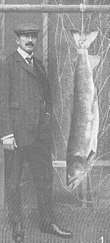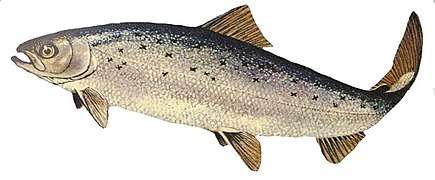Huchen
| Huchen | |
|---|---|
.jpg) | |
| Scientific classification | |
| Kingdom: | Animalia |
| Phylum: | Chordata |
| Class: | Actinopterygii |
| Order: | Salmoniformes |
| Family: | Salmonidae |
| Subfamily: | Salmoninae |
| Genus: | Hucho |
| Species: | H. hucho |
| Binomial name | |
| Hucho hucho | |
The huchen (/ˈhuːxən/) or Danube salmon (Hucho hucho) is a large species of freshwater fish in the salmon family of order Salmoniformes. It is the type species of its genus.[2][3]
Distribution and ecology
The huchen is endemic to the Danube basin in Europe where the remaining population is threatened primarily by habitat fragmentation and loss through river impoundment and disruption of the longitudinal continuity of rivers, cutting away fish from its spawning grounds. Additionally, overfishing and fisheries mismanagement is still a problem in many areas, especially in the Balkans.[4][1] The upper reaches of the basin's rivers and tributaries contain almost all of the recent population,. This includes the upper Drava with the lower Gail (in Carinthia), the Pielach (Lower Austria), the upper Mur (in Styria); in the Balkans the headwaters of Sava (in Slovenia), the upper and middle course of Kupa (in Croatia), the upper and middle Una with the upper and middle Sana, the upper and middle Vrbas, the four main tributaries of the Bosna(the Krivaja, the Fojnička, the Lašva and the Željeznica) without occurrence in the main channel, the upper and middle Drina (all in Bosnia) and its tributaries; the entire course of the Lim (in Bosnia, Serbia and Montenegro), the entire course of the Ćehotina (in Bosnia and Montenegro), and the entire course of the Tara (in Bosnia and Montenegro). Some of these habitats are endangered by planned or already implemented plans for construction of new dams and hydroelectric power plants, especially in the Balkans.[3] Along the Inn river, around the 30 km (19 mi)-long rebuilt and renaturalized area around the Bavarian town of Mühldorf, the huchen has returned in recent years.[5].
It has been introduced to other major river basins elsewhere on the continent and even North Africa, to rivers in Morocco, but these populations are not self-sustaining.[1] Some evidence suggest that in historic times the huchen has also been found in the neighboring Dniester basin. Huchen sometimes successfully establish in accessible natural lakes, like glacial Lake Plav which is the source of the Lim river in Montenegro, one of the major huchen major habitats in the Balkans. However, the species sometimes survives even when cut off from the rest of the population in big dam reservoirs on mountain rivers, such as reservoirs on the Drina in Bosnia, or Lake Czorsztyn in Poland, as long as competitive and/or allochthonous predator species are not introduced into the newly created lakes.[6]
Appearance and behaviour
The huchen reaches about 1.5 m (4 ft 11 in) in length and more than 50 kg (110 lb) in weight.[7] The average length is between 60 to 120 centimetres (24 to 47 in). The huchen has a slender body that is nearly round in cross-section. On the reddish brown back are several dark patches in an X or crescent shape, but most distinctive feature is fishes head, which is larger than in other salmonides (longer and wider), with large elongated mouth. Smaller fish feed on the larvae of water insects or on insects dropped into the water; the larger individuals are predators of other species of fish and other small vertebrates such as mice found swimming in rivers.
Historical occurrence
There is no international convention nor single agreed body concerned with verification of records and mandated with the task, however there are many modern and historical records for the largest huchen caught. Among these recorded is fish weighing 34.8 kg (77 lb), caught in February 1985 in Spittal an der Drau in Austria,[8]; also one weighing 39.4 kg (87 lb), which is stuffed and was probably grown on fish-farm in Austria for breeding.[9] Other storied examples of recorded specimens with existing photographs and media reports include 58 kg (128 lb), caught in January 1938 by Bosnian railway worker and angler Halil Sofradžija at the Dragojevića Rapids on the Drina river, near the town of Ustikolina in Bosnia and Herzegovina. This case was recorded on photograph and reportage was later publeshed in prime Serbian daily Politika on 23 February 1938.[10][11] Dževat Šarkinović, angler from Plav, caught Danube salmon weighting 41.3 kg (91 lb), 145 cm (57 in) long, in late spring of 1985 in lake Plav,[12] and gave it to Hotel "Plavsko jezero" who presented it at International Fair of Hunting and Fishing in Novi Sad where it was noted as a "world record". Today, this specimen stands as stuffed exhibit at the wall of hotel's foyer in Plav.[10][13][14] Another recorded trophy from the Drina include huchen caught by angler Remzija Krkalić from Foča in 1940, weighing 36 kg (79 lb).[15][10]
Reproduction
This permanent freshwater salmonid spawns in April, once water reaches a temperature of 6 to 9 °C (43 to 48 °F). For spawning, the huchen migrates up the river and enters small and shallow affluents, where females excavate depressions in the gravel into which they deposit their eggs, then a male releases a cloud of sperm and the female then covers the eggs with sand.[16] Larvae hatch 30 to 35 days after fertilization.
Commercial breeding

There is a considerable effort to produce huchen fry commercially and to reintroduce the species into the wild with moderate to good success. This requires catching the adults just before spawning and keeping them in special tanks. Fry are released in appropriate places once they have reached 4 to 10 cm (1.6 to 3.9 in).[17]
References
- 1 2 3 Freyhof, J. & Kottelat, M. (2008). "Hucho hucho". The IUCN Red List of Threatened Species. IUCN. 2008: e.T10264A3186143. doi:10.2305/IUCN.UK.2008.RLTS.T10264A3186143.en. Retrieved 12 January 2018.
- ↑ "Hucho hucho". Integrated Taxonomic Information System. Retrieved 11 December 2004.
- 1 2 "Huchen Study 2015" (pdf). balkanrivers.net. Save the Blue Heart of Europe. Retrieved 12 September 2018.
- ↑ Muhamedagić, Samir; Habibović, Emir (1 January 2013). "The State and Perspective of Danube huchen (Hucho hucho) in Bosnia and Herzegovina" (pdf). Archives of Polish Fisheries. 21 (3): 155–160. doi:10.2478/aopf-2013-0012. Retrieved 13 September 2018.
- ↑ years http://tvthek.orf.at/live/Themenmontag-Inn-Der-gruene-Fluss-aus-den-Alpen/13917644 years Check
|url=value (help). Missing or empty|title=(help) - ↑ "Danube salmon in Poland". poland-fishing.blogspot.com. Retrieved 2011-03-19.
- ↑ Froese, Rainer and Pauly, Daniel, eds. (2013). "Hucho hucho" in FishBase. February 2013 version.
- ↑ "International Game Fish Association World Record archives". Retrieved 12 April 2015.
- ↑ "World Records / Fresh Water Fishing". Retrieved 12 April 2015.
- 1 2 3 "Danube Salmon (Hucho Hucho) - it's living space and relatives". www.sloflyfishing.com. Retrieved 14 September 2018.
- ↑ "Danube salmon-hucho hucho in Slovenia". flydreamers.com. Fly dreamers. Retrieved 14 September 2018.
- ↑ "Fishing Worldrecords". www.fishing-worldrecords.com. Retrieved 14 September 2018.
- ↑ "Prokletije". putokaz.me (in Serbo-Croatian). Putokaz. Retrieved 14 September 2018.
- ↑ "Amfibija sa Palića spasava Plavsko jezero?". www.novosti.rs (in Serbian). Retrieved 14 September 2018.
- ↑ "Generaly about Huchen and Grayling - The enchanted angler". www.huchen-angler.com. Retrieved 14 September 2018.
- ↑ Thorpe, Nick. "The beast of the Danube". BBC News. BBC. Retrieved 23 March 2015.
- ↑ "Ep 4: Danube, 29th April 2018 - Animal Planet US". Retrieved 2 May 2018.

